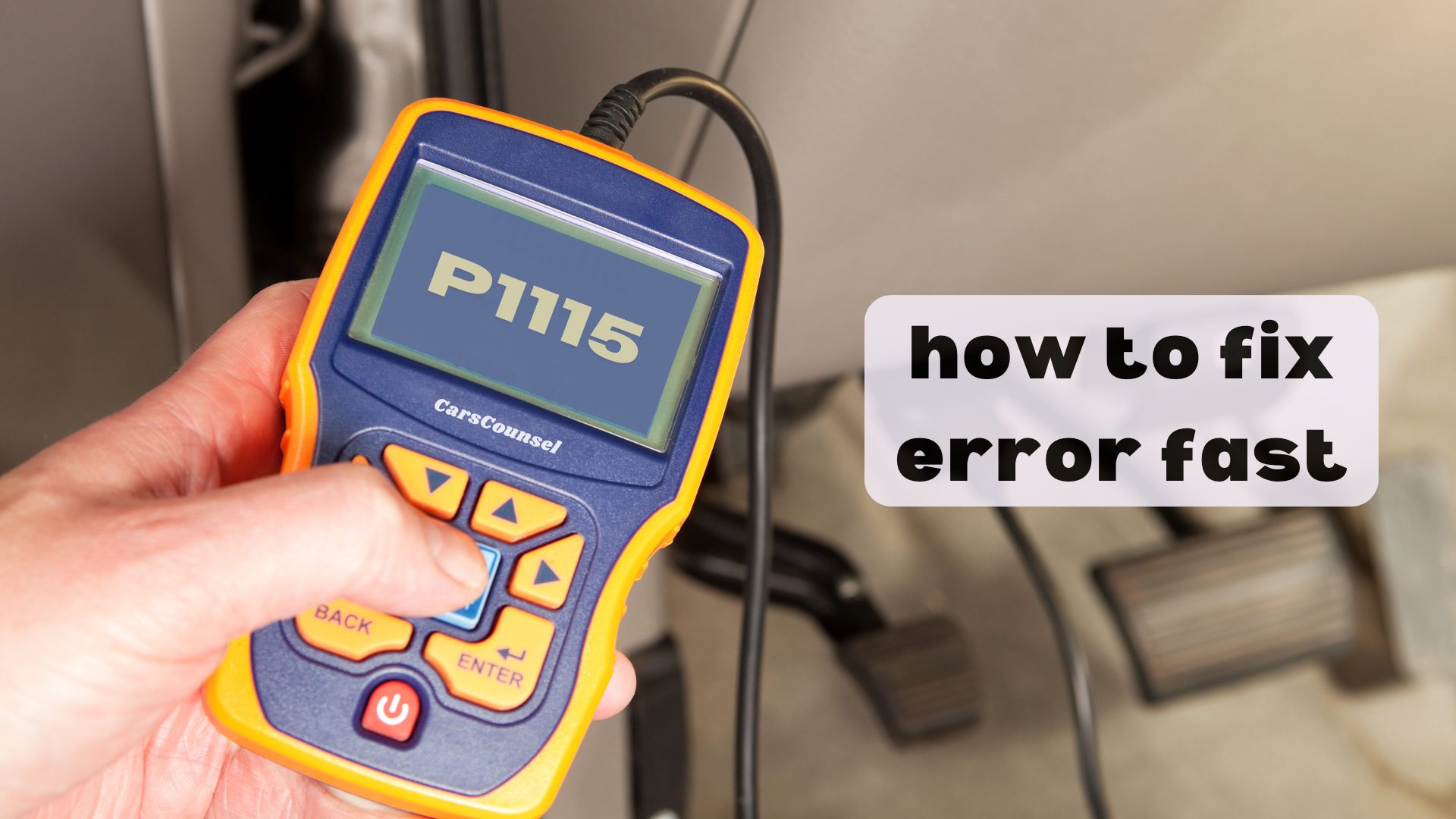If your car’s onboard computer has thrown the P1115 code, it’s telling you that the intake air temperature sensor 2 circuit is running too hot. That’s a problem, because it can cause your engine to run rough, waste fuel, and pump out more pollutants than it should.
You might not notice anything out of the ordinary just yet, but if you don’t address this issue, you could be looking at misfires, stalling, and a whole lot of frustration down the road. So, what’s behind this code, and how do you fix it?

Quick Navigation
Key Takeaways
- The P1115 code indicates a problem with the intake air temperature sensor 2 circuit being too high, affecting engine performance and fuel efficiency.
- A faulty sensor or wiring issues are likely causes of the code, which can lead to incorrect temperature readings and engine operation.
- Symptoms of the P1115 code include reduced fuel efficiency, check engine light illumination, rough idling or stalling, and engine overheating.
- To diagnose the issue, connect a scan tool to the vehicle’s onboard computer, check the sensor’s calibration, and inspect the wiring and connectors for damage or corrosion.
- Repairing the P1115 code may involve replacing the faulty sensor, repairing damaged wiring or connectors, and recalibrating the sensor if necessary.
Code P1115 Description
What does code P1115 really mean for your vehicle?
The fault code indicates a problem with the intake air temperature sensor 2 circuit being too high.
This sensor measures the temperature of the air entering the engine, which is vital for the engine control unit to adjust air/fuel mixture and ignition timing.
If left unaddressed, incorrect engine performance, reduced fuel efficiency, and increased emissions can occur.
The engine control unit relies on accurate intake air temperature sensor data to optimize engine performance.
Sensor performance issues can lead to incorrect temperature readings, affecting engine operation.
It’s essential to address this issue promptly to prevent potential damage to the engine due to incorrect air/fuel ratios and timing.
Causes of the P1115 Code
Identify the root cause of the P1115 code by investigating the intake air temperature sensor 2 circuit.
You’ll likely find that a faulty sensor or wiring issues are to blame. A faulty intake air temperature sensor can send incorrect data to the engine control unit, leading to improper air/fuel mixtures and ignition timing.
Wiring issues, such as corrosion or damage, can also disrupt the signal, causing the code to trigger. Other potential causes include air intake leaks or restrictions, engine coolant temperature sensor malfunctions, and even engine control module (ECM) failure.
Identifying P1115 Symptoms
When your vehicle’s engine control unit detects a problem with the intake air temperature sensor 2 circuit, it triggers the P1115 code, which can manifest in several ways. You may notice a decrease in fuel efficiency, as the engine struggles to adjust to the incorrect air/fuel mixture. The check engine light on your dashboard will likely illuminate, and you may experience rough idling or stalling.
| Symptom | Description | Potential Cause |
|---|---|---|
| Reduced Fuel Efficiency | Engine struggles to adjust to incorrect air/fuel mixture | Faulty intake air temperature sensor |
| Check Engine Light | Illuminates on the dashboard | Wiring or connector issues in the sensor circuit |
| Rough Idling/Stalling | Engine misfires due to incorrect ignition timing | Air intake leaks or restrictions |
| Engine Overheating | Engine coolant temperature sensor malfunction | Incorrect engine performance |
Remember to check your air filter and replace it if dirty, as a clogged filter can contribute to the P1115 code.
Diagnosing the P1115 Issue
You’ve identified the symptoms of the P1115 code, now it’s time to diagnose the issue.
To start, connect a scan tool to your vehicle’s onboard computer to retrieve the trouble code. This will give you a better understanding of what’s happening with your intake air temperature sensor 2 circuit.
Check the sensor’s calibration using the scan tool to see if it’s functioning correctly. If not, you may need to recalibrate it.
Next, inspect the wiring and connectors for any signs of damage or corrosion. Make sure they’re clean and secure. If you find any issues, repair or replace them as needed.
Repairing the P1115 Code
Precision is key when repairing the P1115 code, as a faulty intake air temperature sensor 2 circuit can lead to a cascade of engine performance issues.
You’ll need to diagnose the issue by using a scan tool to retrieve the trouble code and check the intake air temperature sensor and wiring for any visible damage.
Replace the faulty sensor if defective, and inspect and repair any damaged wiring or connectors in the sensor circuit.
Don’t forget to replace the air filter, as a dirty filter can affect sensor calibration.
Clear the trouble code and test drive the vehicle to verify the issue has been resolved.
Remember to monitor the intake air temperature sensor readings to confirm proper calibration and avoid future issues.
Troubleshooting Tech Notes
In troubleshooting the P1115 code, it’s essential to keep in mind that air intake leaks or restrictions can also trigger this code, so don’t focus solely on the intake air temperature sensor itself.
This means you should inspect the entire intake system for any signs of leaks or blockages before diving into sensor testing and wiring inspection.
- Perform a thorough wiring inspection to identify any damaged or corroded wiring or connectors that could be causing the high circuit reading.
- Conduct sensor testing to determine if the intake air temperature sensor is functioning correctly or if it needs to be replaced.
- Check the engine control module (ECM) for any software updates or issues that could be contributing to the P1115 code.
Cost to Fix P1115 Code
When dealing with the P1115 code, it’s essential to weigh the cost of repairs, which can vary widely depending on the root cause of the problem.
You’ll need to ponder the cost of sensor replacement, which can range from $50 to $150, depending on the type and quality of the sensor. Labor estimates will also vary, with rates ranging from $80 to $150 per hour.
If you’re lucky, the issue might be a simple wiring or connector problem, but if the engine control module is faulty, you could be looking at a much higher total repair cost.
On average, you can expect to pay anywhere from $150 to $500 or more to fix the P1115 code, so it’s essential to reflect on whether a repair or replacement is the best option for your vehicle.
Preventing Future P1115 Issues
How can you prevent your vehicle from experiencing future P1115 issues?
To avoid the hassle and cost of repairing this problem again, it’s essential to take proactive measures.
Regular maintenance is key.
Verify that your vehicle’s air filter is clean, and the air intake system is free from leaks or restrictions.
Sensor calibration is vital.
Make sure the intake air temperature sensor is calibrated correctly to provide accurate readings to the engine control unit.
Monitor your vehicle’s performance regularly.
Keep an eye on the dashboard lights, fuel efficiency, and engine performance.
If you notice any unusual symptoms, address them promptly to prevent minor issues from becoming major problems.
More OBD-II Codes
Conclusion
Don’t let a faulty intake air temperature sensor 2 circuit leave your engine sputtering like a worn-out sparkler on a rainy Fourth of July. Addressing the P1115 code promptly is key to avoiding a chain reaction of problems. Remember, a well-maintained engine is like a finely tuned orchestra – every sensor and component plays a crucial role in harmony. By following the diagnosis and repair steps outlined above, you’ll be back to smooth sailing in no time.

